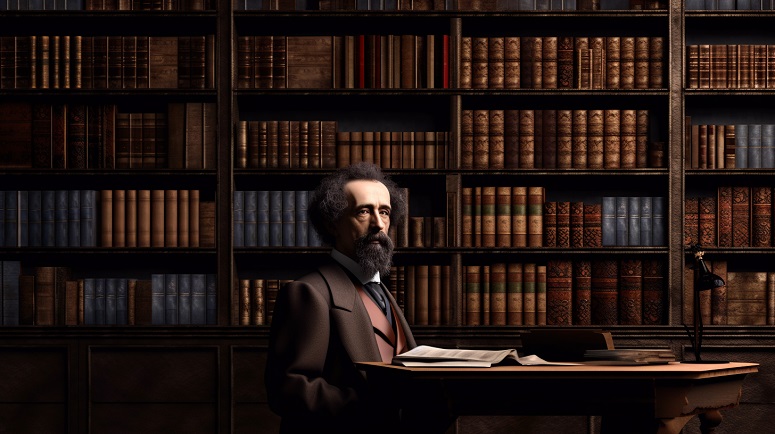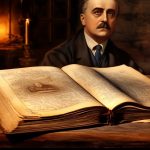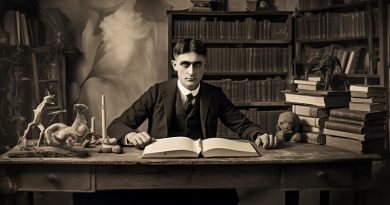Charles Dickens: A Legendary Tale of a Literary Genius
Charles Dickens, the iconic British author, remains one of the most celebrated figures in literary history. Born on February 7, 1812, in Portsmouth, England, Dickens’ early life was marked by hardship and poverty. His father’s imprisonment for debt led to young Charles working in a blacking factory at the tender age of twelve. These experiences deeply influenced his writing and inspired many unforgettable characters who faced similar adversities.
Despite his challenging upbringing, Charles Dickens would rise to become one of the greatest novelists of the Victorian era. He began his career as a journalist before publishing his first novel, “The Pickwick Papers,” in 1836. This episodic tale brought him instant fame and paved the way for numerous other successful works that followed suit.
Early life and education
Charles Dickens was born on February 7, 1812, in Portsmouth, England. He was the second of eight children in a lower-middle-class family. Dickens’ father worked as a clerk in the Navy Pay Office, but his job instability and mounting debts eventually led to financial difficulties for the family. At the age of 12, Charles’s father was imprisoned for debt, forcing him to leave school and work at Warren’s Blacking Warehouse to help support his family.
During this challenging time, Dickens experienced firsthand the harsh conditions faced by many working-class individuals. These early experiences would later influence his writing, as he became known for shedding light on social injustices prevalent during Victorian England. After several years of working at the warehouse and enduring challenging circumstances, Dickens returned to education when his father received an inheritance that allowed him to pay off his debts.
In 1824, at the age of 12, Charles began attending Wellington House Academy in London. His time at this school was short-lived due to financial constraints once again arising within his family. Consequently, after only two years of formal education there – from ages 14 to 15 – Dickens left school and found employment as an office boy at a law firm. Despite these limited educational opportunities during his early life, Charles Dickens‘ innate talent and determination would propel him towards becoming one of the most renowned writers in history.
Dickens’ childhood and schooling
Charles Dickens, one of the most renowned English writers of all time, had a childhood filled with both hardship and inspiration. Born on February 7, 1812, in Portsmouth, England, Dickens was the second of eight children. His father worked as a clerk in the Navy Pay Office but struggled financially. When Dickens was just nine years old, his family moved to London due to financial difficulties. This move would prove pivotal in shaping his future works as he experienced firsthand the poverty and social injustices that plagued Victorian society.
Dickens’ schooling also played a significant role in his development as an author. At the age of twelve, following his father’s imprisonment for debt, young Charles was sent to work at Warren’s Blacking Warehouse. This experience marked a turning point in his life as he endured long hours and harsh conditions while pasting labels on bottles of shoe polish. The dehumanizing nature of this job left an indelible mark on him and greatly influenced many themes present in his later novels regarding class struggle and inequality.
Despite these challenges, Dickens remained determined to educate himself. He attended Wellington House Academy for a short period before returning home due to financial constraints. Nevertheless, he continued his education by reading extensively at home and attending public lectures whenever possible. His thirst for knowledge never waned even when faced with adversity during his formative years – a testament to his resilience and unwavering dedication to self-improvement that would ultimately propel him towards literary greatness.
Influences on his writing style
One of the key influences on Charles Dickens‘ writing style was his childhood experiences. Growing up in poverty and facing social injustices, Dickens developed a deep empathy for the underprivileged and a keen eye for social inequality. These early experiences shaped his writing, as he often depicted the hardships faced by the working class and exposed the flaws of Victorian society. His works, such as “Oliver Twist” and “David Copperfield,” reflect his own personal struggles and serve as powerful critiques of the societal norms of his time.
Another significant influence on Dickens’ writing style was his extensive reading. As a voracious reader from an early age, he was exposed to a wide range of literary genres and styles. This exposure allowed him to develop a rich vocabulary, intricate plotlines, and memorable characters that became hallmarks of his work. Moreover, Dickens drew inspiration from various literary traditions, incorporating elements from gothic novels, sentimental literature, and moralistic tales. The fusion of these influences contributed to the unique blend of humor, satire, sentimentality, and melodrama found in many of his novels.
Career beginnings and early success
Charles Dickens, one of the greatest writers in English literature, had a humble beginning that laid the foundation for his successful career. Born into a lower-middle-class family in Portsmouth, England, he experienced financial hardships and had to leave school at the age of 12 to work in a factory. However, his love for reading and writing never waned. He began working as a law clerk and journalist, contributing articles and essays to various newspapers and magazines under different pseudonyms. These early experiences helped him sharpen his skills as a writer while also exposing him to the social injustices prevalent during Victorian England.
Dickens’ breakthrough came with the publication of his first novel, “The Pickwick Papers,” which was serialized between 1836 and 1837. This humorous tale about the misadventures of Mr. Samuel Pickwick and his friends became an instant success among readers. The popularity of this novel catapulted Dickens into literary stardom at just 24 years old. Following this triumph, he went on to write several other beloved novels such as “Oliver Twist,” “A Tale of Two Cities,” and “Great Expectations.” His unique storytelling style combined with vivid characters portrayed both societal issues and personal struggles, making him an influential figure not only in literature but also in advocating for social reforms during his time.
Charles Dickens‘ career beginnings might have been marked by adversity and hardship; however, through perseverance and talent, he achieved remarkable success that continues to be celebrated even today.
His first published works
In 1833, Charles Dickens had his first published work called “A Dinner at Poplar Walk” in a monthly magazine titled The Monthly Magazine. This humorous piece showcased his talent for storytelling and characterization, setting the groundwork for his future success as a writer. The story revolves around a failed dinner party where the host, Mr. Tom Smart, tries to impress his guests but ultimately ends up embarrassing himself.
Following this early publication, Dickens began writing sketches and short stories for various publications such as The Evening Chronicle and The Morning Chronicle. These works allowed him to experiment with different genres and themes while honing his skills as a writer. His ability to capture social issues of the time within engaging narratives quickly gained attention and praise from readers.
By 1836, Dickens had established himself as a prominent writer with the publication of “The Pickwick Papers,” which was released in monthly installments. This novel catapulted him into literary stardom, showcasing his talent for vivid descriptions, memorable characters, and social commentary. It marked the beginning of an illustrious career that would cement Dickens’ place in literary history as one of the greatest novelists of all time.
The rise to fame and recognition
Charles Dickens, the renowned English writer and social critic, experienced a remarkable rise to fame and recognition throughout his life and career. Born in 1812, Dickens grew up in a working-class family but faced financial difficulties due to his father’s debt. His early struggles greatly influenced his writing style and themes as he often portrayed the hardships of the lower classes in Victorian England.
Dickens gained initial recognition for his serialized novel “The Pickwick Papers” (1836-1837), which captivated readers with its humorous characters and vivid descriptions. This success marked the beginning of his ascent to literary fame. He went on to write numerous novels that are now considered classics, such as “Oliver Twist,” “David Copperfield,” and “Great Expectations.” Dickens’ ability to create memorable characters, combined with his keen observations of society’s injustices, made him incredibly popular among both critics and readers.
His fame extended beyond literature; Dickens was also an accomplished public speaker who delivered dramatic readings from his works throughout Britain and America. These performances showcased not only his storytelling skills but also helped solidify his reputation as a talented entertainer. Despite facing personal tragedies later in life, including the death of two children, Charles Dickens continued writing until his passing in 1870. Today, he is remembered as one of the greatest writers of all time whose works remain timeless classics cherished by millions worldwide.
Major works and literary achievements
Charles Dickens, the renowned English writer, is widely celebrated for his major works and literary achievements. His first novel, “The Pickwick Papers,” published in 1836-1837, marked the beginning of his successful career as a novelist. This episodic comic masterpiece not only garnered immense popularity but also paved the way for Dickens’ subsequent novels.
One of Charles Dickens‘ most revered works is undoubtedly “Great Expectations,” which was published between 1860 and 1861. This bildungsroman delves into themes of social class, identity, and personal growth through its protagonist Pip’s journey from an orphan to a gentleman. The novel’s intricate plotline and memorable characters have established it as an enduring classic in the literary canon.
Another notable achievement in Dickens’ repertoire is his beloved novella “A Christmas Carol.” Published in 1843, this heartwarming tale has become synonymous with Christmas itself. Through the character of Ebenezer Scrooge, Dickens explores themes of redemption and compassion while providing a scathing critique of Victorian society’s indifference towards the poor.
In conclusion, Charles Dickens left an indelible mark on literature with numerous major works that continue to captivate readers around the world. From his early success with “The Pickwick Papers” to timeless classics like “Great Expectations” and “A Christmas Carol,” these literary achievements solidify Dickens’ status as one of England’s greatest writers.
Analysis of popular novels
Charles Dickens, one of the most renowned English writers, left an indelible mark on the literary world with his captivating novels. Born in 1812, Dickens experienced a tumultuous childhood that greatly influenced his storytelling style. His works often depicted the social injustices and inequalities prevalent during Victorian England, exposing the harsh realities faced by the lower classes.
Dickens’ career took off with the publication of “The Pickwick Papers” in 1836. This comedic novel introduced a cast of eccentric characters and showcased Dickens’ knack for intricate plotlines intertwined with humor. Subsequent novels such as “Oliver Twist,” “A Tale of Two Cities,” and “Great Expectations” further solidified his reputation as a master storyteller.
With rich character development and vivid descriptions, Dickens had an unparalleled ability to transport readers into 19th-century London. His keen observations on poverty, child labor, and class divisions resonated deeply with readers at the time and continue to do so today. Through his compelling narratives, Charles Dickens immortalized himself as a literary genius whose works remain beloved classics studied by scholars and enjoyed by countless readers worldwide.
Impact on Victorian literature
Charles Dickens, one of the most prominent figures in Victorian literature, had a profound impact on the literary landscape of his time. His works not only entertained readers but also shed light on the social and economic issues prevalent during the Victorian era. Dickens’s novels, such as “Oliver Twist,” “Great Expectations,” and “A Tale of Two Cities,” exposed the harsh realities faced by the lower classes in society, highlighting themes of poverty, injustice, and exploitation. Through his vivid characters and compelling narratives, he provided a voice for those who were marginalized and brought attention to societal problems that were often ignored.
Moreover, Dickens’s writing style was instrumental in shaping Victorian literature. He popularized serial publication, releasing his novels in installments that left readers eagerly anticipating each new chapter. This method not only allowed him to build suspense but also made his works more accessible to a wider audience due to their affordability. Additionally, Dickens was known for his vivid descriptions and memorable characters that captured the essence of life during this period. From the iconic Ebenezer Scrooge to the lovable orphan Oliver Twist, these characters became archetypes within Victorian literature and greatly influenced subsequent writers.
In conclusion, Charles Dickens‘s impact on Victorian literature cannot be overstated. His novels served as a reflection of social injustices while simultaneously entertaining readers with gripping plots and unforgettable characters. By shedding light on societal issues through engaging storytelling techniques like serial publication and vivid characterizations, he revolutionized how literature was consumed at that time.
Personal Life and Relationships:
In addition to his illustrious literary career, Charles Dickens had a complex personal life and relationships. He married Catherine Hogarth in 1836, and together they had ten children. However, their marriage was far from happy, enduring numerous marital problems that ultimately led to their separation in 1858. This tumultuous period of his life greatly influenced Dickens’ writing, as he often drew upon personal experiences for the themes of love, marriage, and family dynamics depicted in his novels.
Beyond his troubled marriage, Dickens had a vibrant social life and formed several significant friendships throughout his lifetime. One such friendship was with fellow author Wilkie Collins, the two shared not only a professional collaboration but also a deep bond of friendship that lasted until Dickens’ death. Additionally, Dickens forged a close relationship with actor William Macready and became actively involved in theatrical productions during the height of his career. These personal connections not only provided Dickens with much-needed support but also inspired him to explore various aspects of human relationships within his storytelling.
Overall, Charles Dickens‘ personal life played an integral role in shaping both the content and emotional depth of his works. His own experiences with love, family strife, and enduring friendships undoubtedly enriched the themes present in many of his iconic novels—an aspect that continues to captivate readers worldwide even today.
Marriages, family, and friendships
Marriages, family, and friendships played a significant role in the life of Charles Dickens. In his personal life, Dickens experienced both the joys and challenges that come with marriage. He married Catherine Hogarth in 1836, and they had ten children together. However, their marriage eventually deteriorated due to various factors, including Dickens’ infidelity and his dissatisfaction with Catherine’s intellectual abilities.
In terms of family relationships, Dickens had a complex dynamic with his parents. His father was imprisoned for debt when Charles was just twelve years old, which deeply impacted him. This experience influenced many of Dickens’ writings that explored themes of poverty and social injustice. On the other hand, he shared a close bond with his mother; her character even served as inspiration for some of his most beloved maternal figures in novels like David Copperfield and Great Expectations.
Dickens also valued friendships immensely throughout his life. One notable friendship he formed was with fellow author Wilkie Collins. The two writers collaborated on several projects and became integral parts of each other’s lives. Additionally, Dickens built lasting connections within literary circles through his involvement in various clubs and societies.
Social activism and philanthropy
Charles Dickens, known for his celebrated literary works such as “A Christmas Carol” and “Oliver Twist,” was not only a prolific writer but also an ardent social activist and philanthropist. Throughout his life and career, he championed various causes, shedding light on the harsh realities of Victorian society. His novels often exposed the injustices faced by the poor and working-class individuals, addressing issues like child labor, poverty, and inequality.
Dickens’s commitment to social activism extended beyond his writing. He actively participated in philanthropic efforts aimed at improving the lives of those less fortunate. He founded Urania Cottage, a home for “fallen women” where they could find refuge and support to rebuild their lives away from societal judgment. Additionally, Dickens used his platform to advocate for educational reform and access to education for all children regardless of their socioeconomic background.
In conclusion, Charles Dickens‘s legacy goes far beyond his contribution to literature; he remains an influential figure in social activism and philanthropy. Through his writings and direct involvement in charitable initiatives, he fought tirelessly against societal injustices while striving to bring about positive change in Victorian England. His passion for making a difference continues to inspire generations even today.
Dickens’ advocacy for social reform
Charles Dickens, renowned for his captivating storytelling, demonstrated a remarkable commitment to advocating for social reform throughout his life and career. Born in 1812 in England, Dickens was exposed to the harsh realities of poverty and injustice from a young age. These experiences deeply influenced his writing and fueled his fervent desire to bring attention to societal issues. As an author, Dickens used his novels as a platform to shed light on the struggles of the working class, exposing the inequalities they faced. His iconic works such as “Oliver Twist” and “A Tale of Two Cities” painted vivid portraits of poverty, crime, and corruption, effectively raising awareness about these pressing matters.
Dickens’ advocacy extended beyond just depicting social issues in his novels; he actively participated in various philanthropic endeavors as well. In 1843, he published “A Christmas Carol,” which not only captivated readers with its heartwarming tale but also highlighted the plight of the poor during Victorian times. The novella’s protagonist, Ebenezer Scrooge’s transformation from a miserly individual into a generous benefactor served as an allegory for society’s need to address economic inequality through compassion and charity.
Furthermore, Dickens personally involved himself in charitable organizations that aimed at improving conditions for marginalized communities. He supported causes such as education access for children from low-income families and campaigned against child labor laws that exploited vulnerable youngsters.
Charitable activities and initiatives
One of the notable aspects of Charles Dickens‘ life and career was his involvement in various charitable activities and initiatives. He firmly believed in using his platform and influence to make a positive difference in society, particularly for the less fortunate. Dickens was deeply concerned about the living conditions of the poor during the Victorian era, which he vividly depicted in his novels. His works like “Oliver Twist” and “A Christmas Carol” shed light on social issues such as poverty, child labor, and inequality.
In addition to raising awareness through his writing, Dickens actively engaged in philanthropic endeavors himself. He organized public readings of his works to raise funds for charitable organizations like hospitals, orphanages, and schools. For instance, he supported London’s Great Ormond Street Hospital by frequently hosting charity performances there. Furthermore, Dickens played an instrumental role in establishing Urania Cottage—a home for female ‘fallen’ individuals—where he provided support to rehabilitate women who had been involved in prostitution or faced other forms of moral degradation.
Charles Dickens‘ dedication to charitable activities demonstrated not only his empathy but also his determination to bring about positive social change. Through both his literary masterpieces and direct involvement with various initiatives, he left a lasting impact on society by highlighting societal injustices and inspiring others to take action towards creating a more equitable world.
Legacy and lasting impact
Charles Dickens, one of the most beloved and iconic authors in literary history, left a lasting legacy that continues to be felt today. Born in 1812, Dickens grew up in poverty and his experiences heavily influenced his writings, shining a light on social injustices and championing the rights of the working class. His novels, such as “Oliver Twist,” “Great Expectations,” and “A Tale of Two Cities,” have become timeless classics that are still widely read and studied.
Dickens’ impact on literature extended beyond just his storytelling prowess. He played a significant role in shaping the Victorian novel genre with his unique writing style characterized by vivid descriptions, memorable characters, and intricate plotlines. His works transcended social boundaries, appealing to both the educated elite and common readers alike. Moreover, Dickens’ influence on popular culture is undeniable; many of his characters have become household names and phrases from his books have entered into everyday language.
Even after his death in 1870, Charles Dickens‘ legacy endured through various adaptations of his works for stage plays, films, television series, and musicals. His stories continue to captivate audiences worldwide with their timeless themes of love, compassion, redemption, and social justice. Dickens’ ability to capture the human condition with such depth has cemented him as one of literature’s greatest writers whose impact will undoubtedly last for generations to come.
Continued popularity of his works
Charles Dickens, one of the most celebrated Victorian authors, continues to captivate readers around the world with his timeless works. His novels have remained popular for over a century due to their rich storytelling, memorable characters, and social commentary that remains relevant even today. Dickens had an uncanny ability to depict the struggles and triumphs of ordinary people in a way that resonated with readers from all walks of life.
One reason for the continued popularity of Dickens’ works is his masterful storytelling technique. With intricate plots, unexpected twists, and vivid descriptions, he had a unique talent for creating narratives that kept readers engrossed until the very end. Whether it was the heartwarming tale of redemption in “A Christmas Carol,” or the poignant exploration of social inequality in “Great Expectations,” Dickens knew how to craft stories that touched people’s hearts and provoked thought.
Another factor contributing to Dickens’ enduring popularity is his creation of unforgettable characters. From iconic figures like Ebenezer Scrooge and Oliver Twist to lesser-known but equally compelling personalities such as Miss Havisham or Fagin, these characters have become part of literary history. Their complexity and depth make them relatable even in contemporary times, making it easy for modern audiences to connect with their struggles and experiences.
In conclusion, Charles Dickens‘ works continue to be beloved by readers due to his exceptional storytelling abilities and his creation of unforgettable characters who resonate across generations.
Influence on modern literature
Charles Dickens, one of the most celebrated authors in history, has had a profound influence on modern literature. Born in 1812, Dickens experienced a tumultuous childhood that shaped his writing style and themes. His works often highlighted social injustices and portrayed the hardships faced by the working class during the Industrial Revolution. This focus on societal issues greatly influenced later authors who sought to shed light on similar concerns.
Dickens’ career took off with the publication of his first novel, “The Pickwick Papers,” which introduced his distinctive wit and storytelling ability. Throughout his prolific writing career, he penned numerous classics such as “Oliver Twist,” “David Copperfield,” and “Great Expectations.” His vivid descriptions of characters, settings, and situations became hallmarks of his work and inspired generations of writers to develop complex narratives filled with memorable personalities.
In addition to shaping narrative techniques, Dickens also left a lasting impact on how literature addresses social issues. His novels exposed the harsh realities faced by marginalized groups in Victorian England, including child laborers, orphans, and those living in poverty. By bringing attention to these struggles through storytelling rather than polemics or essays, Dickens created empathy among readers and encouraged them to advocate for change. This approach resonated deeply with later authors who sought to use literature as a means of addressing societal problems head-on.
Conclusion: The enduring legacy of Charles Dickens.
Charles Dickens, one of the greatest writers in English literature, left behind an enduring legacy that continues to captivate readers today. Throughout his life and career, Dickens not only entertained millions with his vivid storytelling and unforgettable characters, but also shed light on the social injustices and inequalities of Victorian England. His novels, such as “Great Expectations,” “Oliver Twist,” and “A Tale of Two Cities,” remain timeless classics that resonate with readers across generations.
Dickens’ ability to craft compelling narratives filled with memorable characters is perhaps what sets him apart from other writers of his time. From the lovable orphan Oliver Twist to the iconic miser Ebenezer Scrooge in “A Christmas Carol,” Dickens created characters that have become ingrained in popular culture. Moreover, he skillfully utilized satire and humor to expose societal issues, often drawing attention to the plight of the working class and advocating for social reform.
Beyond his literary achievements, Charles Dickens was a philanthropist who used his fame and fortune to improve the lives of others. He actively campaigned for better conditions for children laboring in factories and championed educational reforms. Additionally, he established charitable organizations aimed at providing relief for those struggling with poverty or homelessness.
In conclusion, Charles Dickens’ enduring legacy lies not only in his masterful storytelling but also in his unyielding commitment to addressing social ills through literature and activism. His works continue to inspire empathy and provoke thought on important societal issues even today.












